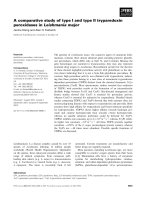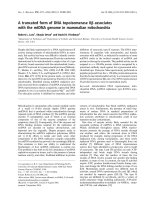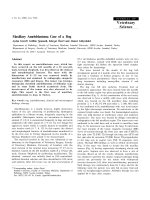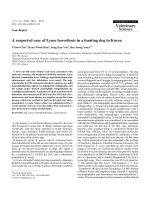Báo cáo khoa học: "A rare case of “switch on and off” multi-system Langerhans cell histiocytosis in an adult patient" doc
Bạn đang xem bản rút gọn của tài liệu. Xem và tải ngay bản đầy đủ của tài liệu tại đây (807.64 KB, 5 trang )
CAS E REP O R T Open Access
A rare case of “switch on and off” multi-system
Langerhans cell histiocytosis in an adult patient
Georgia Karpathiou, Anastasios Koutsopoulos and Marios E Froudarakis
*
Abstract
Introduction: We report the case of a 24-year-old Greek woman with histologically proven osseous and
pulmonary Langerhans cell histiocytosis whose lesions had progressively regressed with a “switch on and off”
mode. This is the first report in the literature of this mode of presentation of Langerhans cell histiocytosis.
Case presentation: The patient had first presented at the age of 20 years with a solitary lesion of the humerus
which spontaneously regressed. At that time, no therapy or smoking cessation was indicated. Four years later she
presented with bilateral pneumothorax and pulmonary lesions of Langerhans cell histiocytosis. She had pleur odesis
for this disease-related complication, and no further systemic treatment was applied, except with regard to
smoking cessation. During the follow-up period, her pulmonary lesions regressed without recurrence six years after
the initial lung involvement.
Conclusion: This uncommon case of remission of multi-system Langerhans cell histiocytosis indicates the
unpredictable evolution of the disease, raising the question of conservative management in such a patient.
Introduction
Langerhans cell histiocytosis (LCH) is a rare clinico-
pathologic entity of unknown etiology with variable sys-
tem involvement, but with the common characteristic of
sizable Langerhans cell infiltration [1]. The clinical
course, as well as the treatment and prognosis of this dis-
ease, are not clearly identifi ed, especially in the adult
population [2]. In pulmonary LCH, smoking cessation is
mandatory, while glucocorticoid therapy, despite being
used, has not been proved to be an effective treatment
method [3]. In multi-system LCH, children with aggres-
sive disease are usually treated with multi-agent che-
motherapy [4,5]. R emission has been observed in single-
system disease after smoking cessation [3,6]. We report a
rare case of “switch on and off” remission of multi-system
disease with alternative bone a nd pulmonary manifesta-
tions in an adult patient after only smoking cessation.
Case presentation
A 24-year-old Greek woman was referred to our hospital
with bilateral pneumothorax. The patient’ ssymptoms
had started four years previously, when she consulted her
personal physician for persistent pain of the right
humerus. The diagnostic approach at the time revealed a
lesion detected by radiography of the right humerus and
confirmed by a bone scan (Figures 1A and 1B), for which
the patient underwent only a biopsy, and no surgical
resection or osseous curettage was performed. Micro-
scopic examination revealed osseous LCH, and neither
further treatment nor follow-up was recommended. At
the time, she was an occasional smoker with normal
chest radiography and high-resolution chest tomography
(HRCT) results, and no smoking cessation was advised.
The patient was symptom-free for the following four
years, at which point she was admitted to our hospital
for the treatment of b ilateral, spontaneous pneu-
mothorax (Figure 2A) and diffused interstitial lung dis-
ease. During the preceding four-year period, she had
increased her cigarette smoking to one pack per day.
She complained of no symptoms, such as cough, dys-
pnea or fever. HRCT showed multiple cysts and nodules
as well as extensive consolidation (Figure 2B). A mild
inflammatory syndrome was observed on the basis of
biological examination. Biopsies taken during a thoraco-
scopy performed for left pleurodesis showed distortion
of the lung architecture and infiltration by Langerhans
histiocytes (Figures 3A and 3B). She tested positive for
* Correspondence:
Department of Pneumonology, Medical School, Democritus University of
Thrace, 68100 Alexandroupolis, Greece
Karpathiou et al. Journal of Medical Case Reports 2011, 5:302
/>JOURNAL OF MEDICAL
CASE REPORTS
© 2011 Karpathiou et al; licensee BioMed C entral Ltd. This is an Open Access article distributed under the terms of the Creative
Commons Attribution License ( which permits unrestricted use, distribution, and
reprodu ction in any medium, provide d the ori ginal work is properly c ited.
S-100 protein and CD1a (Figures 3C and 3 D). Her lung
function tests, performed one month after the resolution
of her pneumothoraces, showed a restrictive syndrome
with decreased static volumes and normal diffusion
capacity factor. The results of her lung function tests
were as follows: forced vital capacity (FVC) = 2.16 L
(63.3%), forced expiratory volume in 1 second (FEV
1
)=
1.76 L (58.9%), FEV
1
/FVC = 81.3% (95. 9%), transfer
coefficient for carbon monoxide (TLCO)/alveolar
volume (VA) = 2 mmol/min/kPa/L (93.3%), residual
volume (RV) = 1.03 L (86.8%), total lung capacity (TLC)
= 3.23 L (71.7%) and functional residual capacity (FRC)
= 1.65 L (65.7%). A new radiographic examination and
bone scan showed the extinction of the lesion on the
right humerus (Figures 1C and 1D). We decided to stop
treatment, except for advising the patient to cease smok-
ing immediately, which she did.
One year later, during her follow-up examination, her
chest X-ray and HRCT (Figures 2C and 2D) were
impressively improved. In addition, improvement was
noted in her static lung volumes: FVC = 2.3L (67.1%),
FEV
1
= 1.8L (60.3%), FEV
1
/FVC = 78.4% (92.5%),
Figure 1 (A) Radiography and (B) bone scan of the right humerus at initial diagnosis showing Langerhans cell histiocytosis
localization on the one-third medium which resolved (C and D) at the time of pulmonary manifestation.
Karpathiou et al. Journal of Medical Case Reports 2011, 5:302
/>Page 2 of 5
TLCO/VA = 2.05 mmol/min/kPa/L (95.6%), RV = 1.20L
(100%), TLC = 4.08L (90.6%) and FRC = 2.05L (81.5%).
To date, after six years of follow-up, the patient has had
no signs or symptoms of disease activity, and her chest
X-rays and lung function tests remain stable.
Discussion
Our patient had multi-system disease involvi ng alterna-
tively bone and lung. The rarity of this case is that this
patient showed remission of her first LCH bone lesion
while she did not interrupt smoking. She developed sec-
ondary pulmonary d isease, which also regressed, after
smoking cessation. This case report describes for the
first time in the literature a “switch on and off” mode of
evolution of LCH.
The c linical course of the LCH varies, while its treat-
ment, outcome and prognosis cannot be precisely
defined, since, owing to its relative rarity, and large, ran-
domized, prospective studies o f this disease are lacking,
especially those concerning adult patients [2,3,7]. Rando-
mized studies performed to date have included children,
whereas the available data concerning the origin of LCH
in adult patients have been reported mainly in retro-
spective studies [2]. However, the results of trials per-
formed with children cannot be completely applied to
adults,astherearedifferencesinthecourseofthe
Figure 2 (A) Radiography of the chest at the time of bilateral pneumothorax revealing pulmonary Langerhans cell histiocytosis. (B)
High-resolution computed tomography (HRCT) of the chest showing multiple cysts associated with nodules and extensive consolidation. (C)
Radiography of the chest and (D) HRCT one year later showing significant improvement of the initial findings and regression of consolidation.
Karpathiou et al. Journal of Medical Case Reports 2011, 5:302
/>Page 3 of 5
disease. In a large cohort of patients, children and adults
studied retrospectively [8], 30.6% had LCH involving
more than one body system, and all of these patients
were treated with surgery, chemotherapy or combination
therapy. The majority of the se treated patients relapsed
and underwent second-line treatment [8].
In data collected from the International Histiocyte
Societ y registry, comprising adult patients, single-system
disease was found in 31% of the patients and 69% had
multi-system disease [7]. The data from that report sup-
ported the great uncertainty and lack of a therapeutic
standard at least for front-line treatment [2]. In general,
multi-system disease is being treated with prednisone,
single-agent chemotherapy or multi-agent chemother-
apy, according to studies performed in children [2,4,5],
whereas in pulmonary LCH, smoking cessation is man-
datory, with glucocorticoid therap y used on the basis of
no evidence-based data [3]. In another retrospective
study of 102 adult patients with pulmonary LCH [9],
treatment included no interventions, except for smoking
cessation in patients with minimal or no symptoms, pre-
dnisone alone or in combination with other immuno-
suppressive agents was prescribed for 54 patients, while
two patients underwent surgical pleurodesis shortly after
the diagnosis and one patient underwent lung transplan-
tation at the time of follow-up. In that study in adults
with pulmonary LCH, no specific interventions showed
any benefit with regard to patient survival [9].
Patients with pulmonary LCH may recover sponta-
neously or remain in stable condition without treatment
Figure 3 (A) Tissue slide revealing an obvious distortion of lung architecture (hematoxylin and eosin stain; original magnification, ×20).
(B) Higher magnification (original magnification, ×200) of the slide in Figure 3A showing the characteristic ovoid Langerhans cells and eosinophils
(hematoxylin and eosin stain). (C) The Langerhans cells demonstrate strong immunoreactivity, both nuclear and cytoplasmic, for S-100 protein
(original magnification, ×400). (D) CD1a stain is also positive in Langerhans cells (original magnification, ×400).
Karpathiou et al. Journal of Medical Case Reports 2011, 5:302
/>Page 4 of 5
[3]. Although pulmonary LCH is usually a single-system
disease in adults, the presenceofabonelesionasan
extrapulmonary manifestation is not so rare [3]. Sponta-
neous regression of bone lesions has also been observed
in adults [6] as well as in infants [10]. Also, in other dif-
fuse interstitial lung diseases of unknown orig in, such as
sarcoidosis, the occurrence of pneumothorax does not
necessarily lead to steroid therapy [11]. In our patient
with LCH, no systemic treatment was applied for the
disease. Pleurodesis was performed for pneumo thorax, a
disease complication, as indicated for patients with
spontaneous secondary pneumothorax [12-14]. At the
same time, she was advised to cease smoking, whi ch she
did. Her pulmonary lesions had secondarily regressed,
and the patient is free of relapse to date.
In conclusion, in our pa tient, LCH osseou s and pul-
monary lesions regressed with a rare “switch on and off”
mode. This uncommon case of remission of multi-system
LCH indicates the unpredictable evolution of the disease,
raising the question of conserv ative management in such
a patient.
Consent
Written informed consent was obtained from our
patient for the publication of this case report and any
accompanying images. A copy of the written consent is
available for review by the Editor-in-Chief of this
journal.
Authors’ contributions
Our patient was admitted under the care of MF during this episode and was
followed up in an outpatient setting. All authors contributed equally in
writing the manuscript. GK wrote the manuscript, AK provided the
histological images and MF corrected and refined the manuscript. All
authors read and approved the final manuscript.
Competing interests
The authors declare that they have no competing interests.
Received: 5 August 2010 Accepted: 11 July 2011 Published: 11 July 2011
References
1. Vassallo R, Ryu JH, Colby TV, Hartman T, Limper AH: Pulmonary
Langerhans’-cell histiocytosis. N Engl J Med 2000, 342:1969-1978.
2. Arico M: Langerhans cell histiocytosis in adults: more questions than
answers? Eur J Cancer 2004, 40:1467-1473.
3. Tazi A: Adult pulmonary Langerhans’ cell histiocytosis. Eur Respir J 2006,
27:1272-1285.
4. Gadner H, Grois N, Arico M, Broadbent V, Ceci A, Jakobson A, Komp D,
Michaelis J, Nicholson S, Potschger U, Pritchard J, Ladisch S, Histiocyte
Society: A randomized trial of treatment for multisystem Langerhans’ cell
histiocytosis. J Pediatr 2001, 138:728-734.
5. Gadner H, Grois N, Pötschger U, Minkov M, Aricò M, Braier J, Broadbent V,
Donadieu J, Henter JI, McCarter R, Ladisch S, Histiocyte Society: Improved
outcome in multisystem Langerhans cell histiocytosis is associated with
therapy intensification. Blood 2008, 111:2556-2562.
6. Kilpatrick SE, Wenger DE, Gilchrist GS, Shives TC, Wollan PC, Unni KK:
Langerhans’ cell histiocytosis (histiocytosis X) of bone: a
clinicopathologic analysis of 263 pediatric and adult cases. Cancer 1995,
76:2471-2484.
7. Aricò M, Girschikofsky M, Généreau T, Klersy C, McClain K, Grois N, Emile JF,
Lukina E, De Juli E, Danesino C: Langerhans cell histiocytosis in adults:
Report from the International Registry of the Histiocyte Society. Eur J
Cancer 2003, 39:2341-2348.
8. Howarth DM, Gilchrist GS, Mullan BP, Wiseman GA, Edmonson JH,
Schomberg PJ: Langerhans cell histiocytosis: diagnosis, natural history,
management, and outcome. Cancer 1999, 85:2278-2290.
9. Vassallo R, Ryu JH, Schroeder DR, Decker PA, Limper AH: Clinical outcomes
of pulmonary Langerhans’-cell histiocytosis in adults. N Engl J Med 2002,
346:484-490.
10. Broadbent V, Pritchard J, Davies EG, Levinsky RJ, Heaf D, Atherton DJ,
Pincott JR, Tucker S: Spontaneous remission of multi-system histiocytosis
X. Lancet 1984, 1:253-254.
11. Froudarakis ME, Bouros D, Voloudaki A, Papiris S, Kottakis Y,
Constantopoulos SH, Siafakas NM: Pneumothorax as a first manifestation
of sarcoidosis. Chest 1997, 112:278-280.
12. Noppen M, De Keukeleire T: Pneumothorax. Respiration 2008, 76:121-127.
13. Tschopp JM, Rami-Porta R, Noppen M, Astoul P:
Management of
spontaneous pneumothorax: state of the art. Eur Respir J 2006,
28:637-650.
14. Mendez JL, Nadrous HF, Vassallo R, Decker PA, Ryu JH: Pneumothorax in
pulmonary Langerhans cell histiocytosis. Chest 2004, 125:1028-1032.
doi:10.1186/1752-1947-5-302
Cite this article as: Karpathiou et al.: A rare case of “switch on and off”
multi-system Langerhans cell histiocytosis in an adult patient. Journal of
Medical Case Reports 2011 5:302.
Submit your next manuscript to BioMed Central
and take full advantage of:
• Convenient online submission
• Thorough peer review
• No space constraints or color figure charges
• Immediate publication on acceptance
• Inclusion in PubMed, CAS, Scopus and Google Scholar
• Research which is freely available for redistribution
Submit your manuscript at
www.biomedcentral.com/submit
Karpathiou et al. Journal of Medical Case Reports 2011, 5:302
/>Page 5 of 5









